
Are you looking for the best stage piano in 2020? Do you know if you want a full scale 88 key instrument or if a 73 or 61 key stage piano will work?
How important are built-in tones and effects in your decision-making process? Does the instrument’s polyphony matter to you (it should)? If so, then look no further than this list of our 10 best stage piano reviews!
What is the Best Digital Stage Piano?
1. Korg SV-2SP – Best Overall
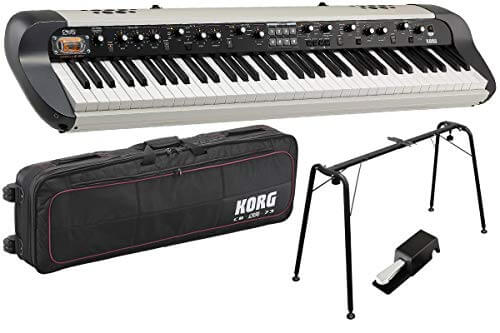
Specifications
- Number of Keys: 73
- Built-in Tones: 72
- Built-in Effects: Yes
- Polyphony: 128 voices
The Korg SV-1 Stage Vintage digital piano debuted 10 years ago. The combination of quality Korg sound samples combined with superior amp modeling technology and superb keyboard action all inside a modern housing turned the SV-1 into THE stage piano to own. Now, Korg has returned with the upgrade model, the SV-2SP, our Best Overall Stage Piano.
The Korg SV-2SP is a 73-key gateway to infinite creativity. The SV-2SP features Korg’s RH3 graded-hammer action keybed designed to mimic the feel of a grand piano.
On a grand piano, the action is heavier in the lower registers and lighter in the upper registers. Additionally, the SV-2SP features 8 adjustable velocity settings, meaning you can control the response of the keys to your taste. This makes the SV-2SP truly customizable in the world of stage pianos.
The SV-2SP features 72 built-in tones including models of classic German, Austrian, Italian, and Japanese grand and upright pianos and a wide range of electric pianos from every decade plus organs, synths, strings, harpsichords, and more. According to the Korg website :
These SV-2 models are the latest additions to the Stage Vintage series … It is quite literally everything one could want in a performance stage piano
One great feature of the SV-2 is its lack of an LCD screen. All the sounds are controlled directly by knobs and switches. There is no need to dive endlessly through a menu to edit a specific parameter.
Overall, the Korg SV-2SP is the best stage piano on the market today and our best overall choice. The combination of highly customizable setup, top of the industry tones, and a hands-on control system put this stage piano in a class by itself. If you have the budget, you won’t be disappointed with the choice!
2. Yamaha P45 – Budget Pick
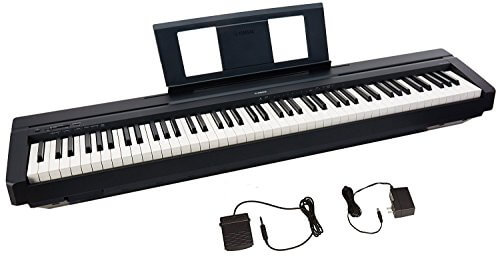
Specifications
- Number of Keys: 88
- Built-in Tones: 10
- Built-in Effects: Yes
- Polyphony: 64 voices
The Yamaha P45 is our budget pick for best stage piano. Yamaha has been a major player in the stage piano realm for decades. The company virtually invented the genre of stage pianos in the 1970’s with its immensely popular CP70 and CP80 electric grand pianos .
The Yamaha P45 is a full-length 88 key keyboard with Yamaha’s GHS Graded Hammer Standard weight system. This instrument features heavier action in the lower registers and lighter action in the higher registers. The P45 features 4 degrees of touch sensitivity: hard, medium, soft, and fixed. These allow a certain degree of flexibility, but not much.
The Yamaha P45 features 10 built-in tones including classic Yamaha piano models, electric pianos, and organs. The sounds are sampled with Yamaha’s AWM Advanced Wave Memory technology that uses a pair of waveforms captured with two different microphones.
Once again, the price point comes into play here.
Additionally, the P45 has only 64 voice polyphony, meaning the instrument can only produce 64 unique pitches at one time.
Overall, the Yamaha P45 is a fine instrument for a beginning pianist interested in a stage piano to perform some first gigs with. This instrument is not for an intermediate or advanced musician. If you are interested in performing seriously long-term, save up your money and get a higher quality instrument.
3. Yamaha CP88 – Best Piano Sounds
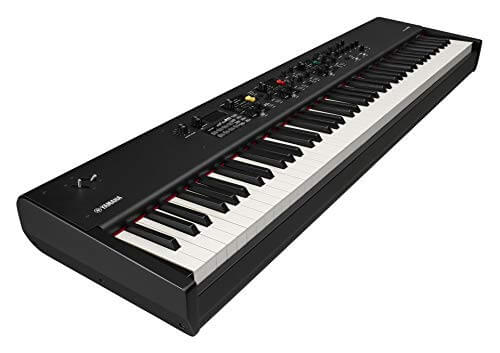
Specifications
- Number of Keys: 88
- Built-in Tones: 57
- Built-in Effects: Yes
- Polyphony: 128 voices
The Yamaha CP88 is Yamaha’s current flagship stage piano model. The CP88 is the update to the CP4 and CP40 and features updated tones, layout, and effects. This instrument is comparable to the Korg SV-2SP. The Yamaha CP88 is our choice for Best Piano Sounds.
The Yamaha CP88 is an 88 key keyboard and uses Yamaha’s proprietary Natural Wood, Graded Hammer, triple sensor system. This is Yamaha’s top-of-the-line keybed for digital pianos. Natural wood keys provide a realistic feeling. The graded hammer action combined with a triple sensor system makes the CP88 feel as close to the real thing as is technologically possible. The keys even include a synthetic ivory and ebony coating, further enhancing the keyboard’s realism.
The Yamaha CP88 features 57 built-in tones that are easily manipulated via knobs and switches on the keyboard’s front panel. The CP88 is designed for the performing professional, so no unnecessary menu diving is required to alter tones on the fly. The CP88 features three premium concert grand pianos: the Yamaha CFX, Yamaha S700 and the Bösendorfer Imperial 290, three of the best pianos in the history of the instrument. Yamaha has done a spectacular job bringing them to life.
Overall, the Yamaha CP88 is an excellent choice for stage piano. The quality of the piano sounds combined with the high-end construction of the keys and the easy-to-access controls produces a stellar stage piano for the performing musician. The CP88 is an expensive instrument, but if you want one of the best stage pianos, you can’t go wrong with this choice.
4. Roland GO:KEYS – Best Keyboard for Mobile Creativity

Specifications
- Number of Keys: 61
- Built-in Tones: 554
- Built-in Effects: Yes
- Polyphony: 128 voices
The Roland GO:KEYS is a unique digital piano and our choice for Best Keyboard for Mobile Creativity. Roland has been a prime player in the digital stage piano realm since the debut of the RD-1000 stage piano in the 1980s . The Roland GO:KEYS takes up this important legacy and adds cool, creative features for more mobile creativity.
The Roland GO:KEYS features 61 keys with a semi-weighted action. Semi-weighted keys rely on a spring-loaded action, as opposed to fully-weighted keys that use a hammer-action like a traditional acoustic piano. However, the keys are designed to feel like authentic ivory and include 4 levels of touch sensitivity and velocity, which gives the GO:KEYS some degree of flexibility.
The true strength of the Roland GO:KEYS lies in its built-in tones and creative capabilities. The GO:KEYS features 554 built-in tones including everything from acoustic and electric pianos to strings, synths, and organs, to electric guitars, basses, and even drum triggers. These different sounds can be layered using the GO:KEYS built-in looping function for creative composition on the fly. This awesome capability means you will be ready to rock right from the start.
Overall, the Roland GO:KEYS is an awesome, creative tool for a digital music maker. While not a true “stage piano” in the traditional sense, the GO:KEYS strength lies in its defiance of convention. No other keyboard can layer music from over 500 tones all in one station. Truly, the Roland GO:KEYS is an awesome mobile creative keyboard.
5. Roland RD-2000

Specifications
- Number of Keys: 88
- Built-in Tones: 1,100
- Built-in Effects: Yes
- Polyphony: 128 voices
The Roland RD series has been a major icon in the world of stage pianos for decades. The company’s latest effort, the RD-2000 packs the most up-to-date technology, samples, and concepts into a truly insane device. The RD-2000 is capable of just about anything you could dream up and is one of the best stage pianos available today.
The Roland RD-2000 features 88 keys with Roland’s PHA-50 Progressive Hammer Action weight system. The PHA-50 action uses triple sensors tuned to be even more reactive to velocity. This makes for a more realistic and expressive playing experience. The keys are built from a hybrid molded plastic and wood combination, further enhancing the authenticity of the keys.
The RD-2000 features Roland’s latest sound modeling updates. The RD-2000 includes two separate state of the art sound engines. The first is designed to model exclusively acoustic piano sounds and is based off Roland’s flagship V-Piano modeling technology. The second is designed to deliver 1100 additional sounds including a wide range of synthesizers, organs, and electronic pianos from the 60s, 70s, 80s, and 90s, as well as a wide range of modeled instruments from other genres.
Overall, the Roland RD-2000 is one of the best stage pianos on the market. The newest technology from an industry pioneer combined with quality materials and craftsmanship form an amazing keyboard for the professional musician. The RD-2000 is comparable to the Yamaha CP-88 or Korg SV-2SP on this list and is also the most expensive instrument here.
6. Kawai MP7
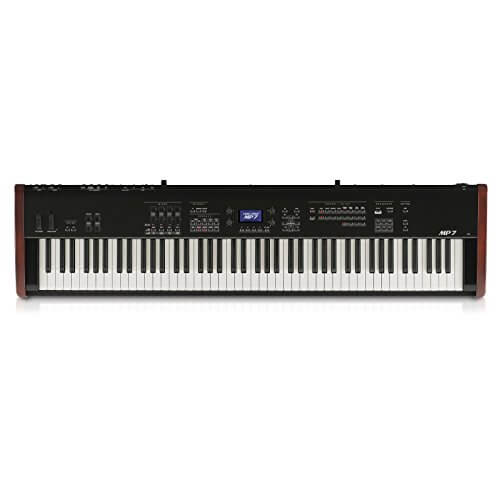
Specifications
- Number of Keys: 88
- Built-in Tones: 256
- Built-in Effects: Yes
- Polyphony: 256 voices
The Kawai MP7 is a real player’s instrument. The Kawai Piano Company began in Japan in 1927 and has since developed into one of the largest manufacturers of acoustic and digital pianos in the world.
They have won numerous awards for their innovative designs, technological advancements, and environmentally sound production practices. The Kawai MP7 is a fully loaded stage piano ready for all creative pursuits.
The Kawai MP7 features a full scale of 88 keys weighted with Kawai’s RH III Responsive Hammer III key action. This key action is designed to mimic the feel of Kawai’s award winning grand pianos and is based off decades of research and development. The MP7 also includes a Let-Off setting and Triple Sensor Detection, further enhancing the realistic nature of the keyboard. The keys are coated with Kawai’s Ivory Touch material to add a final touch of authenticity to the playing experience.
The Kawai MP7 comes loaded with 256 tones that are modeled using Kawai’s Harmonic Imaging XL Sound Technology, a state of the art sample process that, according to Kawai’s website :
… is a blend of technology and techniques aimed at producing the most realistic recreation of our 9-foot concert grand piano possible.
This means you can have the rich depth and beauty of an award winning Kawai piano in the convenient and portable MP7 stage piano. The Kawai MP7 also comes with a stellar 256 voice polyphony, which far exceeds any other instrument on this list!
Overall, the Kawai MP7 is a stellar choice for a stage piano. It has numerous desirable characteristics including a nicely constructed keyboard, great sampling technology, and highly customizable features. It is a wonder these instruments are not nearly as common as the Roland RD or Yamaha CP series stage pianos.
7. Korg SP280BK
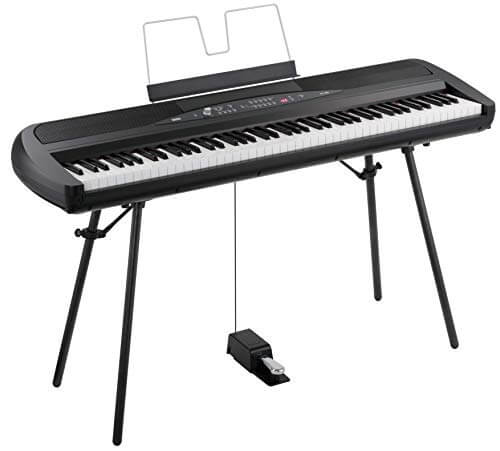
Specifications
- Number of Keys: 88
- Built-in Tones: 30
- Built-in Effects: Yes
- Polyphony: 120 voices
The Korg SP280BK is a mid-level digital stage piano that has many of the design and technological features of the popular SV-2SP at about 1/3 of the price. Korg paid special attention to the back of the instrument with the intention of allowing the SP280BK to stand alone comfortably in a room, without needing to be stored against a wall.
The Korg SP280BK features a full 88 keys using Korg’s Natural Weighted Hammer Action. The NH system is a graded-hammer system, so the keyboard feels heavier in the lower register and lighter in the higher register. The SP280BK also includes a Key Touch Control function with three levels of dynamic to choose from. These are basic functions for a mid-level digital piano.
The SP280BK features 30 built-in tones including grand piano samples, electric pianos, organs, strings, and synths. These instruments can be layered in Layer Mode or the keyboard can be split so that two tones happen at once in Split Mode. Additionally, the SP280BK features a few basic, built-in effects like reverb and chorus.
Overall, the SP280BK is a mid-level digital piano that includes many basic design features. The SP280BK is a step above the Yamaha P45 and Roland GO:KEYS digital pianos and would be a great choice for a home stage piano for an intermediate pianist. I would not recommend this instrument for a performing professional, but it is still probably one of the best digital pianos available today.
8. Casio Privia PX-5S
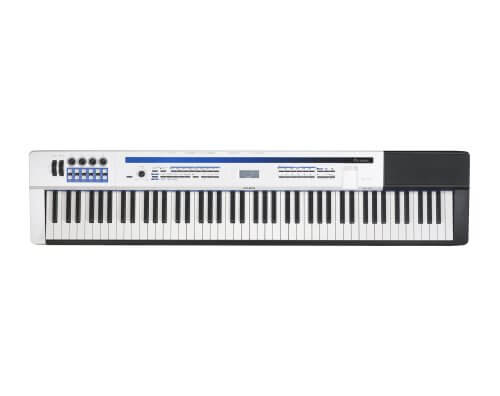
Specifications
- Number of Keys: 88
- Built-in Tones: 370
- Built-in Effects: Yes
- Polyphony: 256 voices
Casio has revolutionized the world of digital pianos. By making digital pianos more affordable, people around the world have been able to access the piano and discover its amazing creative powers. Because of this, many people associate Casio with cheap, low-quality instruments. However, Casio makes a few models that rival the top of the line instruments from other brands. The Casio Privia PX-5s is one such stage piano.
The Casio Privia PX-5S is an 88-key stage piano with Casio’s Tri-Sensor Scaled Hammer Action II Keyboard. Like other high end instruments on this list, this keyboard is designed to mimic the action on an acoustic piano. The keys feature a textured surface like a traditional acoustic piano and touch sensitive controls like many of the other instruments in this review.
The Casio Privia PX-5S features 370 built-in tones, powered by Casio’s proprietary AiR Sound Source technology. This technology provides incredible realism, detail and expression for grand piano sounds and has been expanded to include a 256 voice polyphony which further enhances the instruments fidelity and clarity. The PX-5S also features a number of interesting features more akin to synthesizers such as a sequencer and arpeggiator. No other keyboards on this list have these features.
Overall, the Casio Privia PX-5S is an interesting and unique instrument in the realm of stage pianos. One of Casio’s high-end instruments, the Privia PX-5S packs all of Casio’s accumulated design knowledge into an inspiring, innovative stage piano. If you are interested in the Korg SV-2SP or Yamaha CP-88, consider checking out the Casio Privia PX-5S instead!
9. Roland RD-88
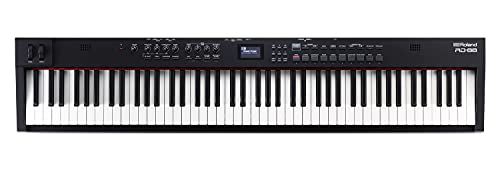
Specifications
- Number of Keys: 88
- Built-in Tones: 3,000
- Built-in Effects: Yes
- Polyphony: 256 voices
The Roland RD-88 is a smaller and more affordable version of the RD-2000 reviewed above. The RD-88 includes many of the features from the RD-2000 in a slimmed down enclosure. The RD series has long been a choice for performing professionals and it is clear to see why.
The Roland RD-88 features a full 88 keys with Roland’s Progressive Hammer Action 4 PHA keyboard action. This is a similar feel to the RD-2000. The RD-88 also features an escapement setting. It is unclear if the escapement setting is adjustable. The RD-88’s keys have an Ivory feel coating designed to mimic the feel of a traditional acoustic piano.
The Roland RD-88 features 3,000 built-in tones powered by Roland’s ZEN-Core and SuperNATURAL piano. This is an insane number of built-in tones and provides a lot of room for creative exploration. The RD-88 also includes a tone editing software for further development and exploration. Access to software synths and three programmable keyboard zones can transform the RD-88 into a full sonic palette for creative performances.
Overall, the Roland RD-88 is a great alternative to the more expensive RD-2000. If you love Roland tones, like the feel of Roland keyboards, and are interested in a stage piano with great creative applications and plenty of room to experiment, then the RD-2000 might be just the right digital piano for you!
10. Nord Electro 6D 61
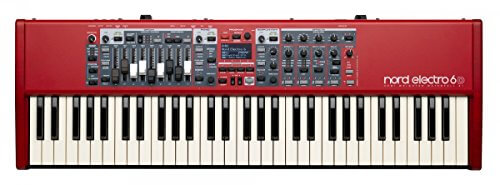
Specifications
- Number of Keys: 61
- Built-in Tones: 120
- Built-in Effects: Yes
- Polyphony: 120 voices
Nord is a Swedish company that has been designing and manufacturing industry-leading digital pianos, synthesizers, and other equipment for a couple decades. They captured the attention of the music industry with their Nord Lead keyboard in 1995 and have not looked back. Nord keyboards are favored by many artists.
The Nord Electro 6D features 61 keys with a semi-weighted waterfall keybed. Semi-weighted keys rely on spring-loaded action to provide resistance, as opposed to hammers on traditional acoustic pianos. This produces a lighter action that is not graduated along the length of the keyboard. This means that the action is consistent along the entire length of the keyboard. The waterfall keys are rounded at the edges, perfect for fast, virtuosic runs and slides.
The Nord Electro 6D features 120 built-in voices including stellar grand and electric piano sounds, an extensive and adjustable organ section, and a highly adept and programmable synth section. The piano section features samples of renowned acoustic grand, upright, and electric pianos.
The organ section features customizable drawbars and a realistic Leslie rotary speaker emulator. The sample synth section features many famous sample-based instruments like Mellotron and Chamberlain and easy access to all parameters.
Overall, the Nord Electro 6D is a comparable choice to the Korg SV-2SP, Roland RD-2000, or Yamaha CP-88 digital pianos. The quality of tones combined with Nord’s beautiful design features makes for a tremendous instrument with infinite creative applications. The semi-weighted waterfall keys are the only detracting feature in my mind.
What To Know Before Buying a Stage Piano?
The Number of Keys
It is important to consider the number of keys when purchasing a stage piano. Are you interested in a keyboard with a full 88 keys? Or will 73 or 61 keys suit your needs? Will you be performing in an ensemble with a bassist? Or will you be performing solo and need to cover bass registers yourself?
If you are planning to perform regularly in an ensemble with a bassist, then covering the bass register is not as important to you. You would be fine with a 73 or 61 key digital piano.
The only instrument with 73 keys on this list is the Korg SV-2SP.
The SV-2SP runs from the low E string on the bass guitar up to what would be the 24th fret on the high E string of an electric guitar. It is a perfect range for performing in an ensemble with a bassist.
Likewise, the Roland GO:KEYS and Nord Electro 6D both feature 61 keys. The register of 61 key digital piano is also perfectly suited for an ensemble with a bassist. Additionally, you could find yourself a nice little bass synth like a Korg Minilogue or Moog Sub Phatty if you need some extra bass tones.
If you will be performing solo more often than not, then you probably want a stage piano with a full 88 keys. That way, you are able to cover the full range of bass pitches in your performance. The last thing you want is to purchase a stage piano with the intention of performing live by yourself and not having all the pitches you need on the instrument!
The Importance of Built-in Tones and Effects
It is also important to consider the built-in tones and effects when purchasing a stage piano. How many tones do you need on your digital piano? Some instruments on this list have over 1000 tones. Will you really use all 1000 of those tones? Or are you simply searching for a few basic tones?
If more tones are better, then either of the Roland RD Series instruments would be perfect for you. Both instruments contain thousands of fully customizable tones and can be augmented with software instruments and editing programs. If you only need a select few piano sounds, the Yamaha CP-88 or Korg SV-2SP would both be great choices. Both have excellent piano sounds without too much extra fluff.
FAQs
Do I Need 88 keys to Learn the Piano?
No, you do not need 88 keys to learn the piano. As long as your instrument has a few octaves, you will be fine. Eventually thought, you will want a larger piano with expanded access to lower and higher octaves.
Do Digital Pianos Feel Like Real Pianos?
Yes, some digital pianos feel like real pianos. In short, it depends on the price and you get what you pay for. Higher-end digital pianos feel just about as close to acoustic pianos as you can get, while cheaper instruments do not.
How Long do Digital Pianos Last?
Digital pianos can last 50 years or more depending on how well you treat them! Digital components will break down with normal wear and tear and, as technology progresses, fewer repair shops cater to vintage electronics. Additionally, vintage components can be difficult to source.
